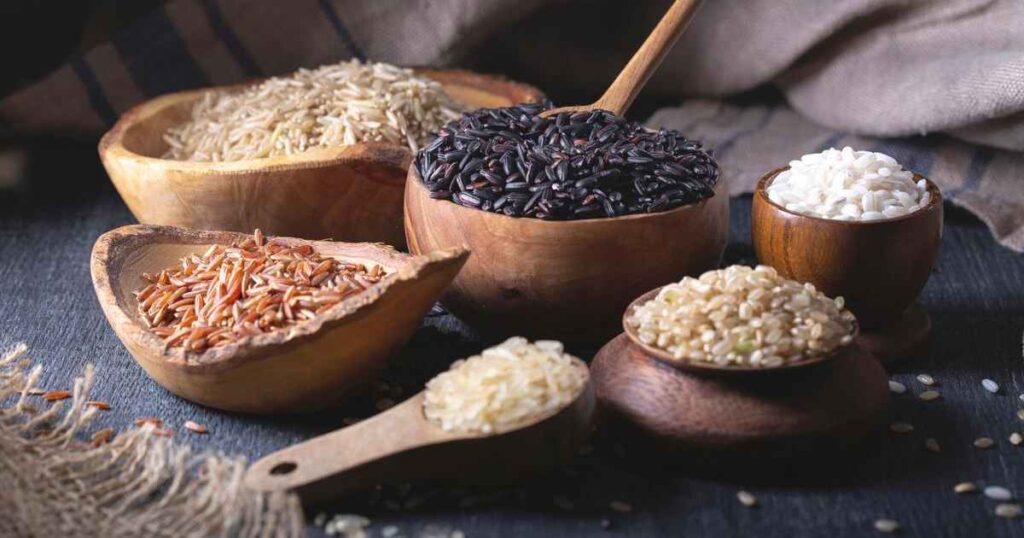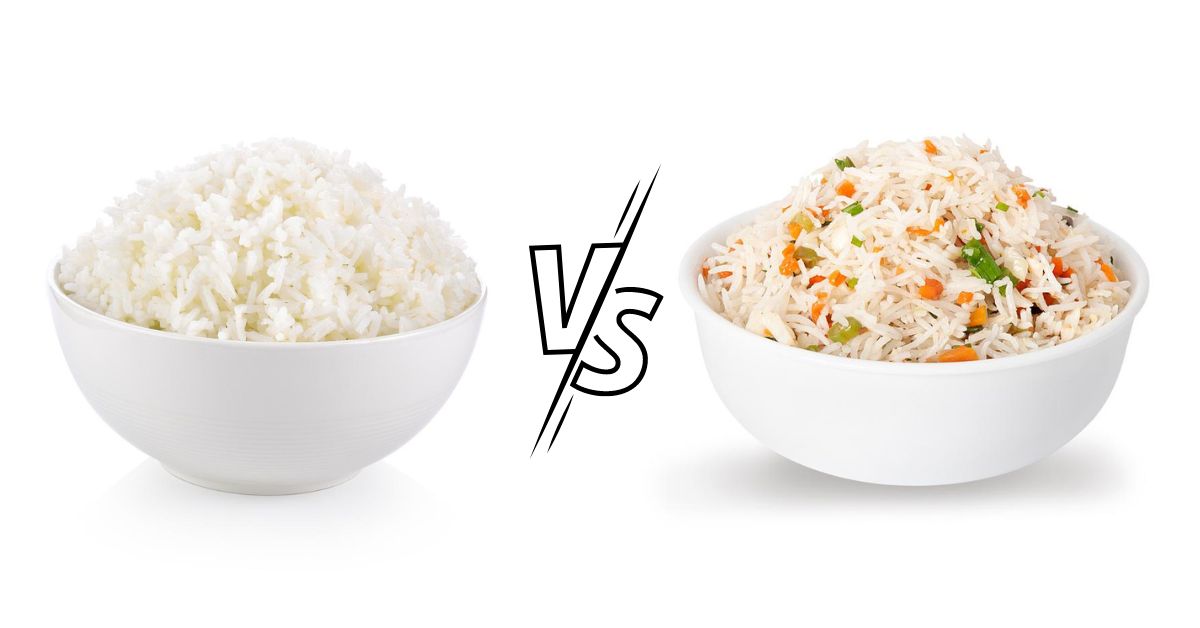Rice, a staple food for a significant portion of the world’s population, is prominent in culinary traditions across various cultures. It’s versatility and widespread consumption have led to a captivating debate: White Rice vs Fried Rice.
This article will explore the key differences between these two popular rice preparations and delve into the factors that make each unique. Whether you’re a rice enthusiast or simply curious about the culinary world, join us as we unravel the nuances of these delicious dishes and gain a deeper understanding of their significance in the culinary landscape.
Table of Contents
ToggleThe Origins of White Rice and Fried Rice
Rice has been cultivated for thousands of years, with its origins tracing back to ancient civilizations in Asia. The origins of white and fried rice can be attributed to different regions and periods.
White rice, characterized by its polished appearance and neutral taste, is believed to have originated in Southeast Asia, particularly in China and Thailand. Over time, the cultivation and refinement of white rice spread across Asia and eventually gained popularity worldwide. Today, it serves as a dietary staple for millions of people.
On the other hand, fried rice has roots in China, which emerged as a clever way to repurpose leftover rice. Initially, it was a humble dish prepared by stir-frying cooked rice with various ingredients such as vegetables, meat, and soy sauce. As Chinese immigrants traveled to different parts of the world, they brought this delectable creation, leading to its integration into local cuisines and subsequent global recognition.
White and fried rice has evolved and adapted to different cultural influences, resulting in various variations and regional specialties. Understanding the origins of these two rice preparations helps us appreciate their diverse culinary heritage.
Nutritional Value of White Rice vs Fried Rice

Regarding nutritional content, white rice, and fried rice have distinct profiles. Let’s examine the critical differences in their nutritional value.
White rice, particularly the polished variety, is predominantly a source of carbohydrates. It is low in fat and protein but contains essential nutrients such as thiamine, niacin, and iron. However, the refining process strips away some of the outer layers of the rice grain, resulting in a loss of specific vitamins, minerals, and dietary fiber.
On the other hand, fried rice offers a more diverse nutrient composition due to the additional ingredients used in its preparation. Vegetables, proteins like chicken or shrimp, and the inclusion of eggs provide a more comprehensive range of vitamins, minerals, and dietary fiber than plain white rice. Using oils or sauces in the frying process can contribute to the overall fat content, so it’s essential to be mindful of the quantities used.
The nutritional value of white and fried rice can be further enhanced by incorporating whole-grain varieties, such as brown rice or wild rice, which retain more bran and germ layers. These whole grain options provide higher fiber content, additional B vitamins, and valuable antioxidants.
It’s worth noting that the nutritional content of fried rice can vary depending on the specific ingredients and cooking methods used. Lightly stir-fried vegetables and lean protein choices contribute to a healthier overall dish, while excessive oil, sodium, or heavy sauces can tip the balance towards a less nutritious option.
Taste and Texture of White Rice vs Fried Rice
The taste and texture of white rice and fried rice differ significantly, offering distinct culinary experiences. Let’s delve into the characteristics that set them apart.
White rice, with its polished grains, has a soft and fluffy texture when properly cooked. It tends to be mild and neutral in taste, allowing it to complement various dishes. The simplicity of white rice makes it a versatile base that can absorb flavors from accompanying sauces, curries, or stir-fry dishes.
On the other hand, Fried rice presents a delightful combination of textures and flavors. The stir-frying process gives the rice a slightly chewy texture while retaining a pleasant bite. The grains are infused with the ingredients’ flavors, such as soy sauce, garlic, ginger, and various seasonings. Including vegetables, meat, and sometimes eggs add contrasting textures and a medley of tastes, creating a satisfying and savory experience.
The flavor profiles of white and fried rice differ significantly due to their respective cooking methods. White rice is mild and acts as a blank canvas, allowing the flavors of accompanying dishes to take center stage. In contrast, fried rice offers a more pronounced umami taste resulting from the stir-frying process, which caramelizes the ingredients and develops a depth of flavor.
Both white rice and fried rice cater to different preferences and occasions. White rice’s subtle taste and fluffy texture make it a versatile choice that pairs well with various cuisines. It is an excellent accompaniment to curries, stews, and saucy dishes. On the other hand, fried rice’s bold flavors and varied textures make it a satisfying and standalone dish, often enjoyed on its own or as a complete meal.
Cooking Techniques and Preparation
Preparing white rice and fried rice involves different cooking techniques and methods. Here’s a step-by-step guide on how to cook each of them:
Cooking White Rice:
- Rinse the rice: Place the desired white rice in a bowl and rinse it under cold water until clear. This helps remove excess starch.
- Measure the water: Use a 1:2 ratio of rice to water. For example, if you have 1 cup of rice, add 2 cups of water.
- Cooking on the stovetop: In a saucepan, bring the water to a boil. Add the rinsed rice, reduce the heat to low, cover the saucepan with a lid, and let it simmer for 15-20 minutes until the rice is tender and the water is absorbed.
- Fluff the rice: Once cooked, remove the saucepan from the heat and let it sit covered for a few minutes. Then, fluff the rice gently with a fork to separate the grains.
Cooking Fried Rice:
- Cook the rice: Start with cooked and cooled rice, preferably leftover from the previous day, as it tends to be drier. This helps prevent the fried rice from becoming mushy.
- Prepare the ingredients: Chop vegetables, such as onions, carrots, peas, and bell peppers. Dice meat or tofu if using. Beat eggs and set them aside.
- Heat a pan or wok: Add oil to a hot pan or wok over medium-high heat.
- Sauté ingredients: Stir-fry the vegetables and meat/tofu until they are cooked and tender. Push them to the side of the pan.
- Scramble eggs: Pour the beaten eggs into the clear space in the pan. Scramble them until they are partially cooked.
- Add rice and seasonings: Add the cooked rice to the pan, breaking up clumps. Drizzle soy sauce, oyster sauce, or other desired seasonings over the rice and mix everything until well combined.
- Fry the rice: Stir-fry the rice and ingredients together for a few minutes until the flavors meld and the rice is heated through.
- Serve hot: Once the fried rice is ready, transfer it to a serving dish and garnish with chopped green onions or cilantro, if desired.
Remember, these steps provide a general guideline, and variations in ingredients, seasonings, and cooking times can be adapted according to personal preferences and regional cuisines.
Variations of White Rice and Fried Rice

White and fried rice offer myriad variations across different cultures and regions, showcasing unique flavors, ingredients, and cooking techniques. Let’s explore some popular variations:
Variations of White Rice
Jasmine Rice: Hailing from Thailand, jasmine rice is known for its fragrant aroma and slightly sticky texture. It pairs well with various Thai dishes and is a staple in Southeast Asian cuisine.
Basmati Rice: Originating from the Indian subcontinent, it is renowned for its long, slender grains and aromatic flavor. It is commonly used in biryanis, pilafs, and other Indian and Middle Eastern dishes.
Sticky Rice: Commonly found in East and Southeast Asian cuisines, sticky rice, glutinous rice, has a moist and chewy texture. It is often used in sushi, sticky rice desserts, and traditional Asian snacks.
Variations of Fried Rice
Yangzhou Fried Rice: A popular Chinese fried rice variation, Yangzhou fried rice features a mix of diced vegetables, shrimp, and ham, stir-fried with fluffy rice. It is seasoned with soy sauce and sometimes incorporates beaten egg for added richness.
Nasi Goreng: Originating from Indonesia, nasi goreng is a flavorful fried rice dish cooked with aromatic spices like shallots, garlic, and shrimp paste. It often includes additional ingredients such as chicken, shrimp, and vegetables, topped with a fried egg.
Kimchi Fried Rice: A beloved Korean dish, kimchi fried rice combines tangy and spicy kimchi with rice, along with additions like diced vegetables, meat, and a fried egg on top. The fermented flavors of kimchi add a unique twist to the dish.
Pineapple Fried Rice: Popular in Thai and Southeast Asian cuisines, pineapple fried rice incorporates chunks of pineapple, along with shrimp, vegetables, and cashew nuts. The sweet and savory combination creates a delightful contrast of flavors.
These are just a few examples of the countless white and fried rice variations worldwide. Each variation showcases the diverse culinary traditions, local ingredients, and regional preferences of different cultures.
You can also read the following: Ice Cream Sandwich Cone | Everything You Need to Know 2023
Health Benefits and Risks of White Rice vs Fried Rice
Understanding white and fried rice’s health benefits and risks is essential for making informed dietary choices. Let’s explore the factors to consider:
Health Benefits of White Rice
Energy Source: White rice is a rich source of carbohydrates, providing the body with vital energy for daily activities and bodily functions.
Nutrient Content: While white rice may have undergone processing that removes some nutrients, it still contains essential minerals like thiamine and iron.
Easy to Digest: The refined nature of white rice makes it easily digestible for many individuals, making it a suitable option for those with digestive sensitivities.
Health Risks of White Rice
High Glycemic Index: White rice has a high glycemic index, meaning it can cause a rapid spike in blood sugar levels. This makes it less favorable for individuals with diabetes or those aiming to manage blood sugar levels.
Low Fiber Content: The refining process removes much of the fiber present in the rice grain, reducing its overall fiber content. This can impact digestive health and contribute to a less satiating meal.
Health Benefits of Fried Rice
Nutrient Density: Fried rice prepared with vegetables, lean proteins, and whole grain options can offer a balanced and nutrient-dense meal. It provides essential vitamins, minerals, and fiber from the added ingredients.
Culinary Creativity: Fried rice allows for the incorporation of diverse flavors and ingredients, making it a versatile dish that can incorporate various nutrient-rich components like vegetables, lean proteins, and healthy fats.
Health Risks of Fried Rice
Caloric Intake: Depending on the cooking method and ingredients, fried rice can be high in calories and unhealthy fats. Excessive oil, sodium, and the inclusion of fatty meats or processed ingredients can contribute to a less healthy dish.
Sodium Content: Some fried rice recipes may include high-sodium sauces or seasonings, which can increase sodium intake. This can concern individuals with high blood pressure or those aiming to reduce sodium intake.
To optimize the health benefits and minimize risks, consider incorporating whole grain varieties of rice, like brown rice or wild rice, which provide more fiber and nutrients. Focusing on stir-frying with minimal oil, containing lean proteins, and loading up on colorful vegetables can help create a healthier and more nutritious fried rice dish.
Cost and Accessibility of White Rice vs Fried Rice
Cost and accessibility are important factors when comparing white rice and fried rice. Let’s explore how these aspects differ for each option:
Cost and Accessibility of White Rice
Affordability: White rice is generally more affordable than other rice or specialty grains. It is widely available in grocery stores and markets, making it accessible to many consumers.
Global Availability: White rice is a staple food in many parts of the world, particularly in regions like Asia, Africa, and Latin America. Its widespread cultivation and global demand ensure its accessibility in various countries and communities.
Versatility in Cooking: White rice’s neutral flavor and soft texture make it versatile for various cooking styles and dishes. It can be used as a base for accompanying sauces, curries, or stir-fried dishes, making it a popular choice for diverse culinary preparations.
Cost and Accessibility of Fried Rice
Ingredient Availability: The cost and accessibility of fried rice can vary depending on the ingredients used. Vegetables, proteins, and additional seasonings play a significant role in the overall price and availability of the dish. Local availability and seasonal variations may influence ingredient choices and cost.
Culinary Skill and Equipment: The accessibility of fried rice may depend on the individual’s culinary skill and access to suitable cooking equipment, such as a stove, wok, or frying pan. However, with basic cooking skills and simple kitchen tools, fried rice can be prepared at home.
Adaptability and Leftovers: One advantage of fried rice is its ability to incorporate leftovers, making it a budget-friendly option. Individuals can create a flavorful and cost-effective dish using leftover rice and various ingredients from previous meals.
White and fried rice offer affordable and accessible options for individuals looking to enjoy a satisfying meal. White rice’s affordability and global availability make it a staple in many households, while fried rice’s adaptability and use of leftover ingredients can contribute to its cost-effective appeal.
Cultural Significance of White Rice vs Fried Rice

White rice and fried rice hold significant cultural importance in various cuisines worldwide. Let’s explore their cultural significance in different regions:
Cultural Significance of White Rice
Asia:
White rice is a staple food in many Asian countries, including China, Japan, Thailand, and India. It is an integral part of daily meals and is often considered the foundation of Asian cuisine. In these cultures, rice represents sustenance, prosperity, and a symbol of cultural heritage.
Rituals and Traditions:
White rice plays a central role in many cultural rituals and traditions. It is a sacred food in religious ceremonies, weddings, and festive occasions across Asia. The meticulous preparation and serving of rice reflect the cultural values of hospitality, respect, and community.
Culinary Diversity:
White rice is a versatile accompaniment to many Asian dishes, such as stir-fries, curries, sushi, and biryanis. Its mild flavor allows it to harmonize with bold and intricate flavors, showcasing the diversity and complexity of Asian culinary traditions.
Cultural Significance of Fried Rice
China:
Fried rice holds a special place in Chinese cuisine and is known for its versatility and adaptability. It originated as a practical way to repurpose leftover rice and transform it into a delicious and satisfying meal. Today, it is a popular street food and an essential part of Chinese banquet menus.
Southeast Asia:
Fried rice, often called “nasi goreng” in the region, is a beloved dish in Indonesia, Malaysia, and Thailand. It reflects the cultural fusion and diversity of Southeast Asian cuisine, incorporating local flavors, spices, and ingredients like shrimp paste, soy sauce, and chili.
Culinary Creativity:
Fried rice allows for culinary creativity and personalization. It allows cooks to experiment with various ingredients, such as vegetables, meats, seafood, and sauces, resulting in a wide range of regional and individual variations.
White and fried rice are deeply embedded in cultural traditions, reflecting different regions’ culinary heritage and diversity. They nourish and sustain communities and serve as a means of artistic expression and connection.
Environmental Impact of White Rice vs Fried Rice
Considering the environmental impact of food choices is crucial in promoting sustainable and responsible consumption. Let’s explore the environmental factors related to white rice and fried rice:
Environmental Impact of White Rice
Water Usage: The cultivation of white rice requires significant amounts of water, as it is typically grown in paddy fields or flooded conditions. Water scarcity and inefficient irrigation practices can contribute to environmental concerns in regions where rice cultivation is prevalent.
Land Use: Rice cultivation demands vast areas of arable land. Deforestation and land conversion for rice production can lead to habitat loss, biodiversity depletion, and soil degradation, affecting local ecosystems and wildlife.
Greenhouse Gas Emissions: The production and processing of white rice can contribute to greenhouse gas emissions, primarily methane. Methane is released during rice cultivation in flooded paddy fields, significantly contributing to global warming.
Environmental Impact of Fried Rice
Ingredient Sourcing: The environmental impact of fried rice depends on its ingredients’ sourcing and production methods. Opting for locally sourced, organic, and sustainably produced ingredients, such as vegetables and proteins, can reduce the carbon footprint associated with the dish.
Food Waste: Fried rice can be an effective way to repurpose leftovers, reducing food waste. Individuals can minimize the environmental impact of food disposal by utilizing leftover rice and ingredients.
Cooking Practices: The environmental impact of frying rice can be influenced by cooking practices. Opting for energy-efficient appliances, using minimal oil, and practicing proper waste management can contribute to a more sustainable cooking process.
Several practices can be adopted to mitigate the environmental impact of rice consumption, including water-saving irrigation techniques, responsible land management, and promoting sustainable farming practices. Additionally, incorporating a variety of grains and plant-based alternatives into one’s diet can help reduce the reliance on rice as a staple food.
Frequently Asked Questions
Which is healthier, fried rice or steamed rice?
Steamed rice is generally considered healthier than fried rice. Steaming rice retains more natural nutrients and has fewer added fats and calories than fried rice.
How many more calories is fried rice than white rice?
Fried rice typically has more calories than plain white rice. The exact calorie difference depends on the specific ingredients and cooking methods used in the fried rice recipe.
Is fried rice just white rice?
Fried rice is made using cooked rice, but it undergoes a stir-frying process with various ingredients like vegetables, meats, and sauces. This transforms the flavor and texture, distinguishing it from plain white rice.
Is white rice healthier than fries?
White rice is generally considered a healthier option compared to fries. While both are high in carbohydrates, white rice is lower in fat and calories. However, it is essential to moderate portions and considers a meal’s balance.
Is white rice better than brown rice?
The nutritional value of white rice and brown rice differs. Brown rice retains its bran and germ layers, making its fiber, vitamins, and minerals higher than white rice. However, when consumed in moderation, white rice can still be part of a balanced diet.
Can you eat white rice every day?
While white rice can be part of a balanced diet, consuming various grains and foods is recommended for optimal nutrition. Incorporating other whole grains like brown rice, quinoa, or whole wheat into your diet can provide additional nutrients and dietary diversity.
Conclusion
White and fried rice have unique characteristics and cultural significance in the culinary world. While white rice is a staple in many cultures and offers a versatile base for various dishes, fried rice showcases creativity and adaptability in transforming leftovers into flavorful meals. Understanding each option’s nutritional value, taste, cooking techniques, and environmental impact allows individuals to make informed choices.
It is essential to consider personal dietary needs, moderation, and incorporating a variety of grains and ingredients to maintain a balanced and enjoyable diet. Whether you prefer the simplicity of white rice or the bold flavors of fried rice, both dishes contribute to the rich tapestry of global cuisine.






